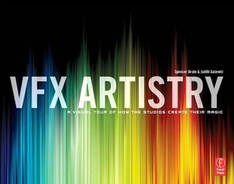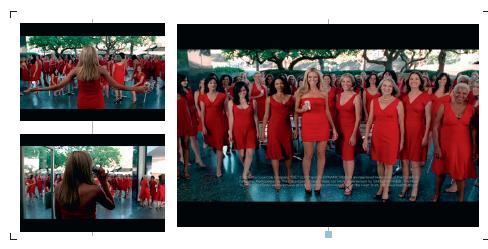24 SEA LEVEL
STUDIO PHILOSOPHY
Founded in 1998 by Spot Welders, Sea Level vFX is a boutique postproduction company providing high-end finishing and effects for commercials, music videos, and content for the web. In November 1998, Jim Bohn and Ben Gibbs were brought on as minority partners in order to bring the quality of service and artist involvement that they had always found lacking in the large facility environment. Its roster of CG supervisors, Flame and Inferno visual effects artists, motion graphics designers, and vFX producers has contributed to award-winning national and international spots for Adidas, Levi's, Honda, Nike, Toyota, Miller Light, MGD, Ikea, Target, and Guitar Hero, among many others. Sea Level vFX works with the industry's most groundbreaking directors, including Spike Jonze, Mike Mills, Fredrik Bond, Patrick Daughters, Jonas Akerlund, Mark Romanek, Tarsem and many others. Gibbs and Bohn left the company in 2007. Currently Sea Level is headed up by Christopher Noellert, who joined the company from Stockholm Sweden as the new Lead vFX Supervisor. The company is based in venice, California.
TOYOTA PRIUS: “UNLITTER”
Creative and Production Process Unlike many shops, Sea Level's approach to digital visual effects has been primarily a 2D or 2.5D solution with 3D additions. While other shops would immediately reach for the 3D switch to flick, Sea Level's visual effects supervisors have been renowned for their ability to construct solutions to commonplace visual effects problems using in-camera techniques combined with compositing brute force and know-how. Much of the best visual effects work completed at Sea Level will be shots you were never meant to notice.
Toyota's “Unlitter,” by contrast, wears its effects “on its sleeve,” making extensive use of grading and rotoscoping techniques. A saturated and vibrant Prius would drive through a dark, drab world, undoing the damage being done to the surroundings and highlighting the Prius's positive effect on the environment. Also by contrast to Diet Coke, the Toyota spot was shot using digital acquisition on the Red one, making it a completely digital production from start to finish.
As color was to play such a large role in the production, the decision was made quite early on to grade all of the material in the Flame rather than performing a grade in a Davinci or Pandora, especially given the complexity of the masking and roto that would be required. Also during preproduction, it was decided that rather than using motion control, the camera would be a series of locked-off highly overcranked shots in order to further highlight the moment as it unfolded.
The postproduction process consisted of two steps. First was compositing the forward-moving Prius over a plate of reversed motion using mainly rotoscoping and keying techniques. Second, the Prius was isolated completely from the background and graded such that it was saturated and bright. The isolated background was in turn graded down, removing significant amounts of saturation and pushing the contrast into a faux bleach bypass. This two-pronged approach held for almost the duration of the spot with a few small deviations, like adding more smoke here and there or simple sky replacements to enhance the overall feeling of doom and gloom.
The ending shot required considerably more attention. The idea was that at the end of the commercial the skies would open up, the sun would shine, and the world would be a better place— conceptually, a difficult message to convey visually in under 4 seconds. On location, there were issues as well. During the location scouting, the production team found a fantastic overpass and down ramp with a scenic view of the city. Unfortunately, closing the overpass for the shoot was completely out of the question, so rather than sacrifice the location, production shot a take of the main action on the car, and then just let the camera roll in order to have enough material to remove the other “unwanted” traffic and bystanders that were present in the master take.
In post, the pieces of the extra material were composited over the master take, so that the Prius essentially drives down an empty on-ramp onto an empty highway. Skyscrapers and lamp poles in the master shot were cut down to make room for more visible sky. As the whole shoot had taken place on an intentionally cloudy and overcast day, a vibrant blue sky was rendered in 3D and a series of feathered and animated rotosplines, atmospherics, and flares were created to reveal the beautiful sky under cloudy sky. Lastly, animated shadows were created to further enhance the feeling of the sun “turning on.”
Tools Flame
Credits
VFX Artist and Title Lead Flame: Chris Noellert
THE COCA-COLA COMPANY:“HEIDI KLUM RED DRESS”
Creative and Production Process The Diet Coke “Red Dress” campaign spot was never intended to be a visual effects spot, and on the surface it's nothing more than a long master shot through a series of different set and wardrobe changes exemplifying Heidi Klum's frantic lifestyle pace. The spot was initially intended to be a single continuous take, shot in-camera; however, on set it became painfully obvious that this approach was not going to work. The interconnected timing of so many events and talent made it too large of a gamble, so the decision was made to break the single shot into three shorter shots in order to reduce the possibility of error. In order to facilitate this new direction, as motion control was never in the scope of the production, each of the three sections started and ended with an element that could be used either to wipe away or reveal the previous or incoming element, respectively.

During editorial the challenge became twofold. There were certain sections of the various takes that the end client and the agency wanted to dwell on for a beat or two longer than was shot. This basically meant that the images would all need to be treated not only in spatial terms, to ensure that the different takes would move seamlessly in and out of each another, but also temporally, adjusting the timing of certain key moments, like dwelling longer on the moment when Heidi Klum reaches out and takes the Diet Coke can.
The postproduction process was a two-pronged approach as well. First, the various takes were lined up and blocked out spatially so that there was some semblance of continuity. This was easier said than done. Each of the takes was camera tracked and stabilized in 3D, negating as much of the perspective shift as possible from the incoming and outgoing takes. Next, a new camera move was created that blended the incoming shot into the outgoing shot, essentially by dissolving one camera data set into the other and then massaging the result so that there were no occlusion issues from objects not present in one take that were missing from the other or improperly timed (as talent rarely can perform the exact same action more than once). The new camera move was then applied to the outgoing and incoming 3D stabilized sources, creating a single continuous shot. Next, occluded and missing objects were added back to the new continuous shot using the camera tracking data and a good deal of rotoscoping, resulting in a final master sequence.
The next issue was the timing of the action from the various takes, now combined into the single master shot. This proved easier than expected, using a combination of rotoscoping, wipes, and motion-estimation-based time remapping.
Credits
VFX Artist and Title Lead Flame: Chris Noellert



